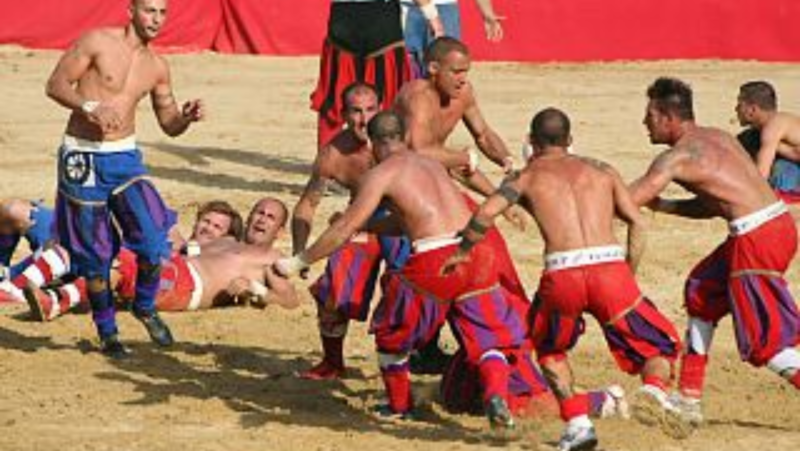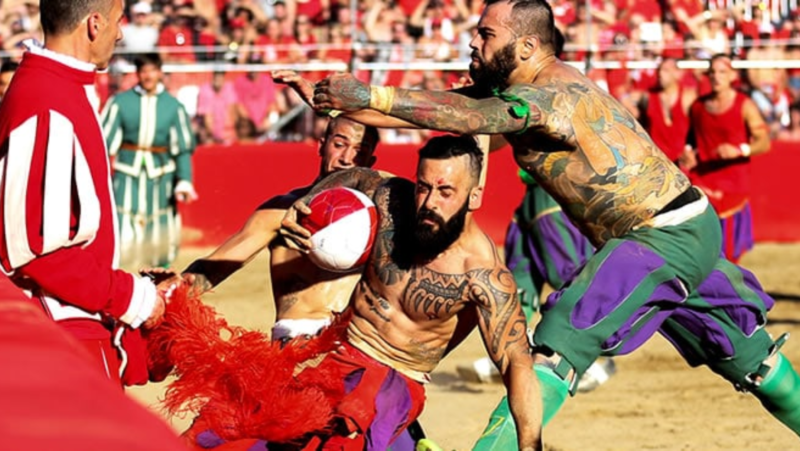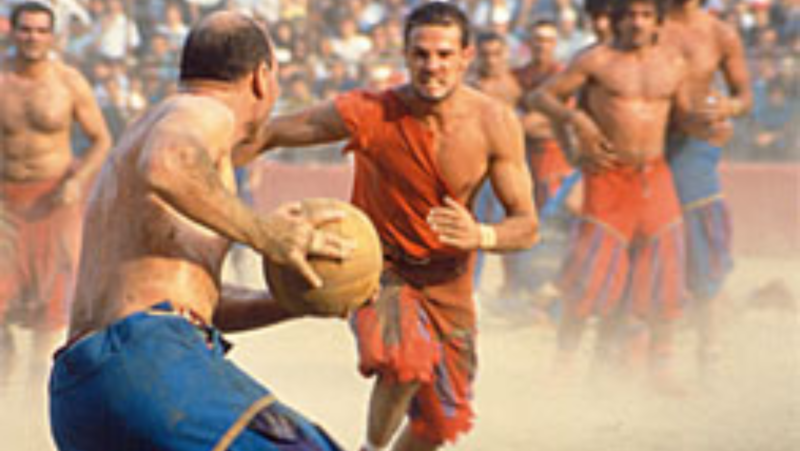• The Tradition of Historic Florentine Football
A Dive into History and Passion
January 26, 2025
Florence is not only the cradle of the Renaissance but also home to centuries-old traditions that continue to captivate and engage both tourists and locals alike. Among these, one of the most spectacular is undoubtedly the Historic Florentine Football, an event that blends sport, history, and entertainment in a one-of-a-kind competition. This discipline represents a true cultural heritage for Florence, passed down from generation to generation, attracting enthusiasts from all over the world eager to discover the city’s historical roots through a timeless spectacle.
One might think that Historic Florentine Football has its roots in ancient Rome, given the widespread popularity of ball games among the great civilizations of the past. The Greeks practiced Spheromachia, a team game later adopted by the Romans under the name Harpastum, derived from the Greek ἁρπάζω (harpázō), meaning “to seize, grab, or take away by force.” Harpastum, played on sandy fields with a ball stuffed with rags, was characterized by intense physicality and fierce competition, making it particularly popular among Roman legionaries who spread it throughout the Empire. Even Emperor Augustus was known to enjoy this sport, as noted by Suetonius in his writings.
According to popular tradition, Historic Florentine Football is considered a direct descendant of this ancient Roman game, adapted and shaped by the Florentine spirit. However, concrete evidence of the game only dates back to the late 15th century. Surprisingly, even Dante Alighieri, who immortalized every aspect of medieval Florence in his verses, makes no mention of it in his works. This leads us to believe that rather than being an ancient legacy, Historic Florentine Football is more likely a product of the creativity and combative spirit of Renaissance Florentines.
Football began to spread among young Florentines who played it in the streets and squares of the city, giving rise to a true social phenomenon. However, the growing popularity of the game led to the need for regulation, moving it to the city’s main squares for public order reasons. The calcianti, men between the ages of 18 and 45, often from the city’s nobility, took to the field wearing richly colored livery, a distinctive element that gave the sport its name.
The matches were moments of spectacle and celebration, mainly organized during Carnival, a period of festivity and merriment for the city. However, the game took on a legendary dimension on February 17, 1530, when, under siege by the imperial troops of Charles V, the Florentines defied their fate by playing a match in Piazza Santa Croce, demonstrating courage and pride in the face of the enemy. Despite the city’s subsequent fall, this episode became a symbol of resistance.
In the 17th century, Historic Florentine Football continued to be played, especially in Piazzale di Porta al Prato, keeping its fame alive. However, with the passage of time and social changes, the tradition gradually declined until it disappeared as an official event. The last documented match took place in January 1739, in the presence of Maria Theresa of Austria.
After nearly two centuries of silence, Historic Florentine Football was rediscovered thanks to the passion of the Florentine people. Two commemorative matches in 1898 and 1902 reignited interest in this tradition, but it was on May 4, 1930, that the true revival of the game occurred.
To commemorate the Florentine leader Francesco Ferrucci on the fourth centenary of his death and the fall of the Republic, a civic committee decided to revive the calcio storico, drawing inspiration from the historic match of February 17, 1530. As reported by the weekly Il Bargello on May 4, 1930, the reenactment celebrated the strength and agility of the Florentine people, recalling the splendor of the past. The event aimed not only to exalt the city’s tradition and attract tourists but also to claim the origins of emerging sports such as football and rugby.
Since 1952, the challenges between Florence’s four historic districts have become a consolidated tradition, turning into a major annual event that today represents the beating heart of the city’s heritage, celebrating Florentine identity with the same passion and pride as in the past.
Recently, two Florentine scholars, Matteo Poggi and Filippo Giovannelli, put forward a fascinating theory suggesting that Historic Florentine Football could be the origin of modern rugby. According to their research, the game was not only played in Florence during the Grand Duchy era but was widespread throughout Tuscany with slight local variations. In Livorno, in 1766, the game featured teams of 50 players and a scoring system that involved throwing the ball beyond the stands behind the goalkeepers, over an imaginary crossbar— a dynamic that closely resembles the rules of modern rugby.
At that time, Livorno was a major commercial port and hosted numerous foreign communities, including a significant presence of English merchants and sailors. According to the scholars, it was precisely this community that may have adopted and introduced the game to England, where it was further codified in the 19th century. Furthermore, historical documents from that period attest to the presence of written regulations governing the matches, a detail that could have influenced the future rules of rugby.
Historic Florentine Football is played on a rectangular field covered with sand, set up in Piazza Santa Croce, with two teams of 27 players each. The players’ roles are divided as follows:
- 4 datori indietro (goalkeepers)
- 3 datori innanzi (fullbacks)
- 5 sconciatori (midfielders)
- 15 innanzi or corridori (forwards)
The objective of the game is to score as many cacce (goals) as possible by placing the ball into the opponent’s net. However, precision is crucial: if the ball goes over the net due to an attacker’s mistake or after being deflected by a defender, half a caccia is awarded to the opposing team. After each goal scored, the teams must switch sides of the field.
The matches last 50 minutes, during which physical clashes are allowed but only in one-on-one confrontations; multiple players attacking a single opponent are prohibited. Tackling an opponent to bring them to the ground is permitted, but striking them is not allowed.
The match is overseen by a head referee, assisted by six linesmen and an administrative judge who monitors the game from the sidelines. The maestro di campo is the highest authority and steps in to restore order in case of disturbances.
The opening ceremony is spectacular: teams enter the field to the sound of drums, followed by the Araldo della Signoria, who reads Le Grida, the official proclamation of the match’s start to the Magnifico Messere or Leggiadra Madonna, an honorary title given to a prominent figure connected to the city. After the reading, the maestro di campo gives the authorization, and the pallaio throws the ball onto the central line of the field. Historic cannons, known as colubrine, fire to mark the beginning of the game.
At the end of the match, the winning team is celebrated with the Inno della Vittoria (Victory Hymn), the awarding of the palio, and the traditional prize of a Chianina breed calf, symbolizing triumph and abundance.
The Division of the Historic Districts
- Santa Maria Novella (Reds) – Located in the northwest part of the city, this district takes its name from the Basilica of Santa Maria Novella. Its symbol is a golden sun on a blue field. The district’s banners (Gonfaloni) are:
- White Lion (Lion Bianco)
- Red Lion (Lion Rosso)
- Viper (Vipera)
- Unicorn (Unicorno)
- San Giovanni (Greens) – The central district, surrounding the Cathedral (Duomo) and the Baptistery of Saint John, which is the spiritual heart of Florence. Its symbol is the depiction of the Baptistery on a blue field. The district’s banners are:
- Keys (Chiavi)
- Ermine (Vaio)
- Green Dragon (Drago Verde)
- Golden Lion (Lion d’oro)
- Santa Croce (Blues) – Located in the eastern part of Florence, it is named after the famous Basilica of Santa Croce, which houses the tombs of illustrious figures such as Michelangelo and Galileo. Its symbol is a golden cross on a blue field. The district’s banners are:
- Ox (Bue)
- Black Lion (Lion Nero)
- Wheels (Ruote)
- Chariot (Carro)
- Santo Spirito (Whites) – Situated in the Oltrarno area, this district represents the authentic and artisan spirit of the city, dominated by the Basilica of Santo Spirito. Its symbol is a white dove on a blue field. The district’s banners are:
- Shell (Nicchio)
- Ladder (Scala)
- Scourge (Sferza)
- Dragon (Drago)
In medieval times, each Gonfalone was an autonomous territorial community responsible for the defense and management of local resources. Each district was in charge of maintaining the walls and internal streets and had its own magistrates and privileges. The district heralds are tasked with representing their neighborhood during official celebrations, presenting the Gonfaloni to the public and proclaiming the achievements of the teams.
The current division of the districts reflects the ancient military and administrative needs of the medieval city. Each district is characterized by a strong sense of belonging, which is expressed in events such as Historic Florentine Football, where they compete with pride and a spirit of rivalry.
Today, these districts remain an integral part of city life, keeping alive the tradition and sense of identity that distinguishes Florence around the world.
The Gonfaloni and institutions together uphold the spirit of Historic Florentine Football, ensuring that it remains not only a competitive event but also a grand celebration of Florence’s rich cultural heritage and community values.
The San Giovanni Tournament consists of three matches:
- Two semifinals, where the teams compete to secure a place in the final.
- The final, which is traditionally held on June 24th, the day Florence celebrates its patron saint, Saint John the Baptist.
The elimination matches take place in the days leading up to the final, with an interval of at least seven days to allow the players to recover their energy for the decisive showdown.
The pairing of teams for the elimination matches takes place during a highly symbolic and evocative ceremony: on Easter morning, during the famous Scoppio del Carro (Explosion of the Cart). On this occasion, in the presence of the highest authorities of Historic Florentine Football—including the President of the Florentine Football Committee, the Maestro di Campo, the Captain of the District and Countryside Guard, and the team Captains—the drawing of the matchups is conducted. Each team is accompanied by its Alfieri (standard-bearers), who serve as proud witnesses of their district’s heritage and sense of belonging.



The images used in this article have been sourced online and are the property of their respective owners. If you are the owner of any of the images and wish to have them removed or properly credited, please contact us.